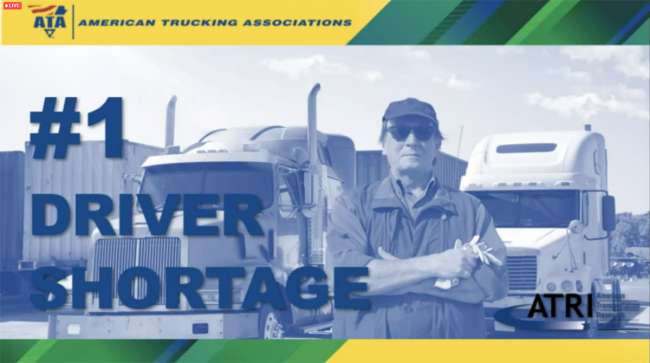Senior Reporter
ATRI Top 10 Report Finds Driver Shortage Top Issue for Fourth Year in a Row

[Stay on top of transportation news: Get TTNews in your inbox.]
For the fourth year in a row, the trucking industry’s persistent driver shortage ranked No. 1 on the annual Top Industry Issues list from the American Transportation Research Institute.
This year, ATRI noted that fleets’ difficulty in hiring is being exacerbated by the COVID-19 pandemic, as the retirements of thousands of drivers, state motor vehicle departments’ inability to test and process new CDL applicants, and the market’s redistribution of freight are coalescing to further stress the pool of available drivers.
In addition, the loss of an estimated 42,000 drivers who are listed in the new Drug and Alcohol Clearinghouse as being disqualified from driving because of substance abuse issues is taking a further toll on the industry.
“It’s hard to tell which of those is the real driver right now, but I’m confident there are drivers who used the pandemic because of their age to say this is my last drive,” ATRI President Rebecca Brewster told Transport Topics. “We know the numbers associated with the drivers who have been taken out because of the Drug and Alcohol Clearinghouse.”
Brewster said driver compensation ranked as the second-most important issue, and likely will remain a significant challenge as it is so closely tied to the driver shortage.
“They are two sides of the coin,” she said, noting that some companies are raising pay to stay competitive.
ATRI, a not-for-profit research institute, unveiled this 16th annual edition of the report on Oct. 27 during American Trucking Associations’ virtual Management Conference & Exhibition.

Rebecca Brewster by Transport Topics
Hours of service, which had ranked in the top three since 2016, fell to 10th place on ATRI’s list, replaced this year by truck parking, which is now third.
Concerns about parking have worsened during the pandemic as drivers, especially in March, April and May, struggled to find hot food and a place to rest.
“It actually got worse during the pandemic, and we point to that primarily with the states that closed their rest areas initially,” Brewster said. “You had a system that is fairly constrained to begin with, and now you’re taking additional capacity out of it. On the driver’s side, they’re saying something has to be done; this is not sustainable.”
Both fleets and drivers participate in the survey. Drivers listed parking as the No. 1 issue, followed by driver compensation/pay. The drivers said detention time/delays at customer facilities was their third-greatest concern. Drivers ranked HOS as their fourth most crucial industry issue, and driver training standards placed fifth.
Number 1 - #Trucking #TruckingResearch #ATRI https://t.co/GGCo4i4JkQ — ATRI (@Truck_Research) October 27, 2020
The fleets’ and drivers’ results were tabulated and put into one combined report, but separate lists for both groups were included in the study. ATRI said a record 3,122 motor carriers, drivers and other industry stakeholders participated in the latest survey.
Ranking fourth was the Federal Motor Carrier Safety Administration’s Compliance, Safety, Accountability system, which for years has drawn the ire of some in trucking. On May 1, FMCSA changed its practice of listing crashes on carriers’ public safety profiles in the system without indicating whether the driver or carrier could have prevented the crash.
Rounding out the top five issues for the overall list was the rising cost and availability of insurance. Although the pandemic briefly eased traffic congestion and the risk of crashes in the short term, several longer-lasting trends have been driving up insurance rates and premiums in the past several years. One key factor contributing to trucking’s increasingly challenging insurance market is the proliferation of “nuclear” verdicts — judgments of $10 million or higher awarded in cases involving truck crashes.
An insurance executive with Sentry Insurance in Stevens Point, Wis., told TT “social inflation” contributes to the growth of these high-dollar awards because plaintiff attorneys are seeking to play on the jurors’ emotions to drive up the cost of verdicts.
ATRI Top Industry Issues 2020 by Transport Topics
“It’s the costs and the premium increases that fleets are facing,” Brewster said. “Everyone’s costs are going up regardless of your experience and whether or not you are at the heart of these nuclear verdicts.”
Rounding out the top 10 were driver retention (No. 6 for the second year in a row), tort reform, which is tied to nuclear verdicts, was seventh. ATA has made tort reform, especially on the state level, a top priority for 2021.
The overall state of the U.S. economy ranked eighth, and detention and delay issues at facilities ranked ninth ahead of HOS.
The entire ATRI report can be found at truckingresearch.org.
Want more news? Listen to today's daily briefing:
Subscribe: Apple Podcasts | Spotify | Amazon Alexa | Google Assistant | More


